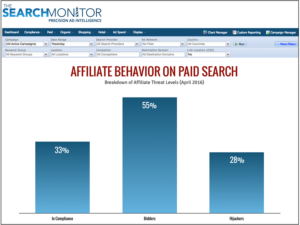The Most Helpful Ad Monitoring Tool for Affiliate Managers
The Search Monitor has been monitoring affiliate activity on search engines and other webpages since 2008. While our data shows that most affiliates do comply with their advertiser’s guidelines, unfortunately 28% are hijacking URLs and trademarks. The chart below illustrates the percentage of affiliates found at each threat level, along with the activity we saw them performing. Note, that URL Hijackers are also guilty of brand bidding, so they are counted in both the Bidders and Hijackers categories.

Some do not realize they are violating their advertiser’s rules, while some simply know they won’t every get caught. Examples include URL hijacking, trademark bidding, and rank violations. Affiliate Managers understand they need to monitor their affiliates frequently and enforce quickly. Our monitoring tools not only catch violations when they happen, they automatically notify you and then provide easy tools to notify your affiliates, the networks, or the search engines. We provide screengrabs of the violation and full background detail on the affiliate, including their IDs, the networks they work with, and other merchants they advertise for.
Affiliate Managers Receive This Ad Monitoring Data:
- Paid Search Detection: – Brand & brand-plus violations – Direct-linking violations – Partner rank violations
- Offer Monitoring: Finds new and expired offers
- Content Monitoring: Monitor landing pages, blogs & email
- Affiliate Profiles: 35,000+ profiles with merchant affiliations
- Geo-monitoring across all major search engines (97% of web traffic!)







 Brand Protection
Brand Protection SEM Insights
SEM Insights Affiliate Compliance
Affiliate Compliance Ad Armor
Ad Armor Learning Center
Learning Center Guides & Webinars
Guides & Webinars We Love Data™
We Love Data™ About Us
About Us Our Data
Our Data Careers
Careers Our Team
Our Team News
News Contact Us
Contact Us

